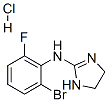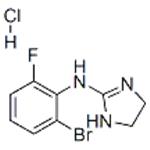Romifidine hydrochloride [N-(2-b romifidineo-6-fluoro-phenyl)- 4,5-dihydro-1H-imidazol-2-amine mono-hydrochloride, C9H9BrFN3, MW 258.1; romifidine] is an imidazole derivative with potent a2-adrenoceptor agonist properties. It is commonly used in equine practice to provide sedation, analgesia, and muscle relaxation. A comparative study reported that an intravenous (i.v.) dose of 80 μg/kg romifidine is equipotent to 1 mg/kg xylazine i.v. and 20 μg/kg detomidine i.v.[1]. Typical signs of sedation include muscle relaxation, decreased head height (HH), diminished responsiveness to external stimuli, and postural abnormalities following romifidine administration. Furthermore, romifidine possesses antinociceptive activity. As an analgesic, it reduces anesthetic requirements for isoflurane in horses.
An α2 agonist use as a sedative and analgesic.
As an α2 agonist used as a sedative and analgesic, RoMifidine Hydrochloride is a drug that is used in veterinary medicine as a sedative mainly in large animals such as horses.
Alpha2 agonists decrease release of neurotransmitters from the neuron. The proposed mechanism whereby they decrease transmission is via binding to presynaptic alpha2 receptors (negative feedback receptors).
[1] M. WOJTASIAK-WYPART. “Pharmacokinetic profile and pharmacodynamic effects of romifidine hydrochloride in the horse.” Journal of veterinary pharmacology and therapeutics 35 5 (2012): 478–488.

